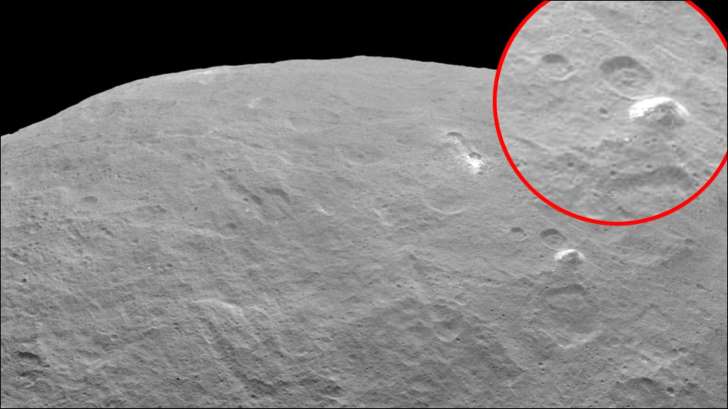July 1, 2015
Scientists are investigating a mysterious, pyramid-shaped mountain on the surface of Ceres.

Dwarf Planet Ceres
The triangular peak was spotted by NASA's Dawn spacecraft as it orbited 2,700 miles above the distant dwarf planet.
The mountain towers three miles above Ceres' flat surface – more than half the height of Everest.
July 1, 2015
Scientists are investigating a mysterious, pyramid-shaped mountain on the surface of Ceres.

Dwarf Planet Ceres
The triangular peak was spotted by NASA's Dawn spacecraft as it orbited 2,700 miles above the distant dwarf planet.
The mountain towers three miles above Ceres' flat surface – more than half the height of Everest.
"Curiouser & curiouser. @NASA_Dawn sees pyramid-shaped peak," NASA tweeted after taking images of the mystery mountain.
As the craft gets closer to Ceres – the largest object in the main asteroid belt between Mars and Jupiter – more and more features are beginning to reveal themselves.
They include "mysterious bright spots" in a 55-mile-wide crater.
At least eight spots can be seen in the largest bright area, which scientists think is approximately six miles wide.
They believe a highly reflective material is responsible for the spots, with ice and salt leading possibilities.
Dawn's infrared mapping spectrometer allows scientists to identify specific minerals on Ceres by looking at how light is reflected. Each mineral reflects light wavelengths in a unique way, allowing experts to determine the planet's rock and ice composition.
As the spacecraft sends back more images and data, NASA will learn more about the bright spots.
Experts have also identified numerous craters of varying sizes, many of which have central peaks.
They say there is "ample evidence" of past activity on the planet's surface, including landslides and collapsed structures.
"The surface of Ceres has revealed many interesting and unique features," said Carol Raymond, deputy principal investigator for the Dawn mission, based at NASA's Jet Propulsion Laboratory in Pasadena, California.
"For example, icy moons in the outer solar system have craters with central pits, but on Ceres central pits in large craters are much more common.
"These and other features will allow us to understand the inner structure of Ceres that we cannot sense directly."
Dawn – the first mission to visit a dwarf planet – arrived at Ceres on 6 March. It will remain at its current 2,700-mile altitude until 30 June, and then will descend to 900 miles in August.
Ceres, named after the Roman goddess of agriculture, was discovered in 1801.
Courtesy: Sky News







































































































